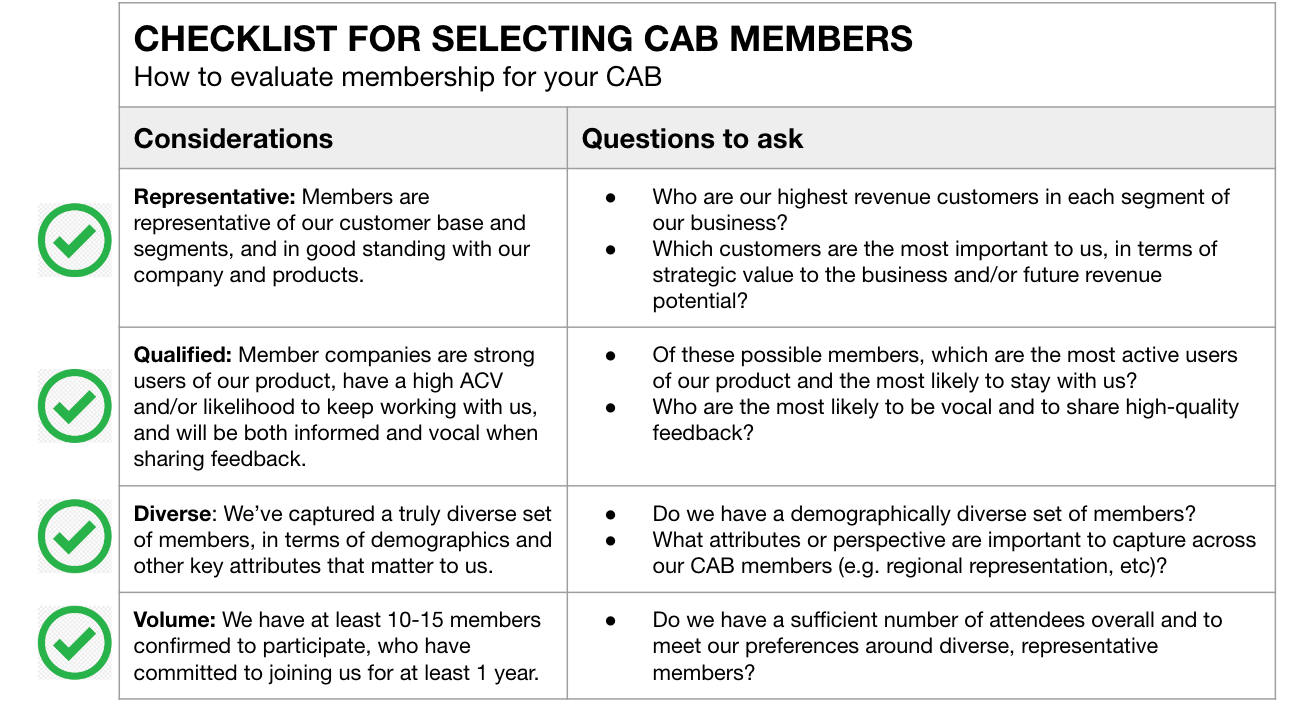How to run a productive Customer Advisory Board
Embracing the gift of customer feedback
A few weeks ago I had the honor of participating in G2’s first in-person Executive Advisory Board. It was an amazing group of marketing thought leaders, including CMOs and leaders from some of the biggest and most influential software companies in the world.
I walked away reminded of the power of customer feedback (such a gift!) and more convinced than ever that all companies should have a CAB.
I also left with a lot of takeaways on how to run a great one. Below I share my tips for creating a great CAB, and how to make the most of it.
💪 Goals
Set a north star goal for the CAB - how do you want it to help grow your business? It could be:
To improve your go-to-market strategy & plans through customer feedback
To shape your product roadmap, to add more value to customers
To improve relationships with top customers
Or something else, or even a combination…
Ideally you’d set one primary goal for your CAB each year, along with some way to evaluate or measure its success.
For example, if your primary goal is to improve your product through feedback, one measure of success might be for the team to feel that the CAB meaningfully influenced the product roadmap and resulted in material changes or additions that enhanced value to customers.
You can also measure the resulting lift in revenue for customers on the CAB, but this is a limiting goal in and of itself.
Don’t overthink the measure of success. The key point is to create clarity on your CAB’s purpose, giving you a north star for prioritizing attendees, agenda items, and even how you act on the feedback. For a CAB, it’s less important for the goal to be exactly measurable than for it to be useful.
In addition to setting goals for the CAB overall, for each meeting (I suggest meeting 2-4 times per year), set specific outcomes you want to achieve and share them with your board members in advance, so they know where to lean in.
🤝 Participants
Invite key customers who can give you critical feedback. Good advisory board members = vocal board members. Somewhere between 10-15 participants is a good aim.
Bring in a diverse set of board members across demographics and also segments. I’ve spoken with companies who worry about putting small or mid-market customers with enterprise customers in a CAB. But if they are a similar persona (e.g. marketing leaders) and you’re equally committed to serving both (or all) segments, then a big part of the CAB magic can be found in bringing them together. You’ll spot patterns across segments and see where the segments’ wants and needs diverge the most.
Companies of different sizes can also learn from each other. Generally speaking, smaller businesses tend to experiment more readily, so they can often teach larger companies on how to innovate with your products. Larger businesses can also help smaller ones understand how to leverage your product at scale – useful perspective as they grow.
If you want to get deeper feedback from a key segment, you can also do focus groups or additional research. But you don’t need to silo your CAB efforts to do this.
❓Agenda
When setting your CAB meeting agendas, leave plenty of time for dialogue and feedback. If the goal of your CAB centers around getting customer feedback, then 70-90% of the agenda should be time for customers to speak and share.
Structure the feedback sessions well by asking in-depth, clear questions. A moderator can be a huge asset in keeping the dialogue flowing and focused on your key topics.
Vague or open-ended questions like “What are you prioritizing next year?” are much less useful than specific questions like “What are 3 things that we could be doing (or doing better) to help you see more value from our products?”
Customers sign up to a CAB to help your business, so don't be afraid to put them to work during your sessions.
✅ Post-Meeting
How will you action on the feedback, and use the time between meetings to keep your board members engaged? Spend time upfront identifying how you’ll consolidate and action on the feedback gathered in your sessions.
The true value of a CAB lies in what happens AFTER the meetings.
So don’t leave the follow up to chance. Plan out:
How you’ll document and circulate key findings to leaders across the company
How you’ll prioritize what to take action on, and which teams will be involved (product, marketing, sales, and customer success are a good start)
How and when you’ll set the next meeting
Finally, make sure you keep board members engaged between meetings.
I’ve seen great success with sending an email from the CEO (or a key leader) 2-3 times a quarter. These emails give members an update on key happenings at the company, inform them of new product updates, or share how their feedback is directly impacting the business. These updates should be simple and quick to create. Just make sure your board members feel like insiders - they should hear updates and big news about your company first, not at the same time as everyone else.
If you don’t have a Customer Advisory Board, consider starting one in the year ahead. It’s the most powerful way to get insightful, deep feedback from your top customers – feedback you can act on quickly to improve your product, positioning, customer success efforts, and more.




